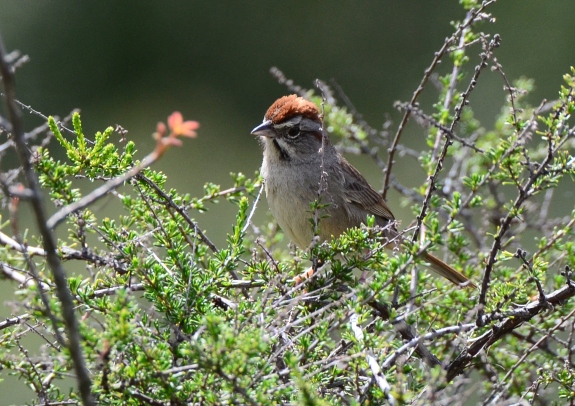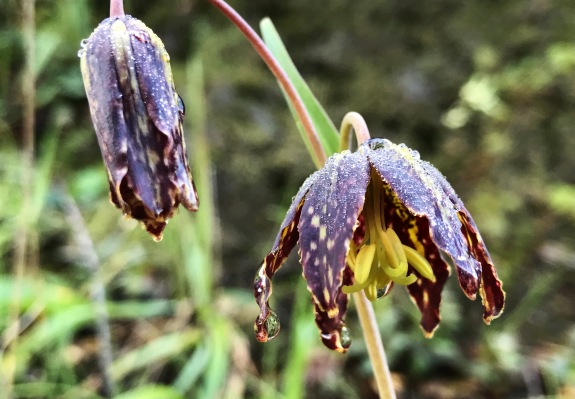At the end of March, Billy and I were growing bolder about where we would take Annabelle, as she was a couple of months old and seemed like a fairly robust little creature, at least compared to her ultra-larval state that she was in back in January. We decided to go for a hike out on the Pine Mountain Fire Road in Marin, where I could potentially get a precious Marin county bird and there was a good chance we would see some decent wildflowers. A few Band-tailed Pigeons crossed over the ridge and into another drainage when we arrived.
Look at this sick habitat shot...BB&B is "not just a bird blog", eh? EH? Sound familiar to anyone? Anyhow, it didn't take long to figure out we were in a serpentine zone, as evidenced by the soil color and interesting plant community that made up this large, impressive swath of chaparral. A Black-chinned Sparrow was found out here after I moved south to San Jose, can't say I was surprised.
I reckon this is Bolinas ceanothus (Ceanothus masonii), which is a serpentine-loving Marin endemic. It was blooming all over the place that morning.
Less endemic but more familiar, a handful of red larkspur (Delphinium nudicaule) was in bloom down near Carson Falls.
Rufous-crowned Sparrow was the main draw for me that morning. We managed to find one pair, but oddly they weren't in any of the huge chaparral patches. They were frolicking in a grassland just downslope from a modestly sized patch of chaparral.
Rufous-crowned Sparrow is very uncommon in Marin, so it was great to check out a new zone and snag a desirable county bird at the same time.
We unwittingly found another highly local being, this one even rarer (but perhaps more dependable) than the sparrow. Carson Falls still hosts foothill yellow-legged frogs, which have been extirpated almost everywhere else in the county.
These stream-loving/pond-hating frogs love a good current and some good basking sites nearby. COUNTY FROG!!!!!!
This was the best flower of the day, checker lily (Fritillaria affinis), looking all dewy and soothing.
Little crippler!
My bastard girls with some nice yellow-legged frog habitat. There's so much good stuff in Marin, it was great to be so close for a few months. Now I am in the process of discovering the good things Santa Clara has to offer. There's no Point Reyes...or ocean...but the shorebirding is great. If only there were some sod farms...
On another day in March I was back at the Las Gallinas Ponds. Cinnamon Teal were still looking as Cinnamon Teal should back then. All the ducks are currently recovering from eclipse plumage now, and don't look like a whole lot.
What a strange body type you have Common Merganser.
This is a long bird. Beware.
A Bewick's Wren offered itself up for a solid crush, which I was obliged to partake in. I'm sure I've mentioned it before, but I can't help but mention it again...Bewick's Wrens are so abundant and adaptable in California, it's strange to think that their eastern populations have fared so poorly in comparison. Is competition with other species (other wrens?) to blame?
Bewick's Wrens have little to fear from Marsh Wrens. By this time Marsh Wrens were belting it out in full force, beckoning the Least Bitterns (local legends) to return. It only works when you do the splits though, which this bird knows. I did snag one of the bitterns for my YOHOMBSLBFTINFOLF eventually, though it was heard only.
Pied-billed Grebe is one of those birds I see constantly but photograph rarely. This extra-fluffy one was too good to pass up.
No wings. Only fluff.
Adults in alternate have a solid black throat, which I admittedly forget about sometimes since I don't spend a lot of time looking at Pied-billed Grebes, despite all the opportunities I have to do so. How would you describe the voice of a PBGR? Jon Dunn (via the Natty Geo field guide) says they deliver "a loud series of gulping noises". Pretty good, they are certainly loud, though American Bittern is considerably gulpier. I would go with loud and hollow "coos" and "cowps", and a series of nasal, rapidly uttered "hey-hey-hey-hey-hey-hey-hey-hey" delivered in the same pitch. Ugh, I can't imagine having to describe a field guide's worth of bird vocalizations.



















👱♀️👶🏻❤️ lovin that fluffy grebe!
ReplyDeleteI thoroughly enjoyed this post's biodiversity. Bird blogs are over, dontcha know?
ReplyDeleteObvi, especially this one!
DeleteI've read that House Wrens target Bewick's Wrens and will regularly destroy their eggs and take their nests. Not sure though.
ReplyDelete